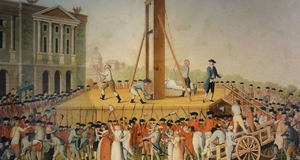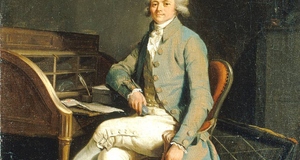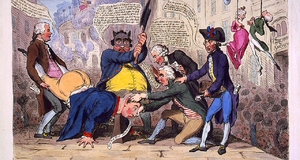Reflecting on the Life of a Revolutionary: Jean-Paul Marat
By
2010, Vol. 2 No. 01 | pg. 2/2 | « Marat’s political career, minus his obvious political journalism, is very controversial, as expected of a radical leader. Although Marat was a deputy at the National Convention, a member of the Committee of Public Safety and an Adviser for the First Paris Commune, he had been arrested numerous times and had to flee France more than once due to his involvement with the Jacobin party. His name was nominated for a position in the legislative body, which lead to resistance from the Girondin party, which Marat would end up crushing in June of 1793.35 Considering the Girondin party was on the right, after their defeat the Jacobins dominated. Conversely, his colleagues did not always respect Marat; his disease-ridden body created poor aromas and many would not go near him.36 There was a long-standing opposition between Danton and Marat, historian Sarel Eimerl claims on the basis of jealousy possessed by Marat. The people of Paris however, were unconditional with Marat, to them he was a hero, and with the people behind him his status was upheld.37 Marat’s death is a prominent factor in how Marat was remembered during the Revolution. Charlotte Corday, a Girondin sympathizer, assassinated Marat in his bathtub.38 Due to Marat’s skin disease, which he is thought to have obtained while hiding in sewers during the early years of the Revolution, Marat spent much of his later years soaking in a medicinal bath.39 It was easy for Corday to locate Marat, as he was readily available to his followers, and many of them knew his address.40 Corday made an appointment with Marat under false pretenses that she had a list of conspirators for him. After Corday gave Marat the names of the alleged traitors, Marat explained with his last words, “Excellent! In a few days’ time I shall have them all guillotined in Paris,” as Corday plunged a knife into Marat’s chest.41 The painting by David The Death of Marat is one of the most famous of the Revolution. It is a graphic image of Marat in his bath with blood dripping from his chest, with a quill in his left hand, which lies lifeless, and a list of the names whom were to be killed in his right hand (Jacques-Louis David, The Death of Marat, 1793, Musees Royaux, Brussels). Corday’s motive was to save her country from civil war. She believed Marat’s influence in the massive violence would lead to the demise of her country, and it was her duty to sacrifice her life to save France.42 However, after Marat’s assassination, his followers martyred him.43 Marat’s image was worshipped; there had never been a political leader at this point that was honored like a religious figure.44 No other figure from the Revolution elicited this response from the people; it has been compared to the Christian’s worship of Jesus.45 Politically, after Marat’s death a dictatorship was instated, and some of the violence ceased for a short period of time.46 Marat’s legacy lived through his supporters.Jean-Paul Marat was one of the most influential men during the French Revolution; he ranks with the established names Robespierre and Danton. His own insecurities and resentments, his ability to relate to the people, his writing ability, and his passion for his country brought him great veneration among the people, while his publications, even today, are considered to have been an overwhelming influence in many of the violent events that took place in France during the Revolution. Marat’s following is what brought him his legacy and his defeat. Although Marat is often regarded as an extremist, his intentions are not in question: “Even Marat, believed [himself] motivated by patriotic or altruist impulses... All in consequence were able to value their good intentions more highly than human life.”47 ReferencesBooks Bax, Ernest Belefort. Jean-Paul Marat: The People’s Friend. London: Grant Richards, 1900. Eimerl, Sarel. Revolution!:France 1789-1794. Boston: Little, Brown and Company, 1967. Loomis, Stanley. Paris in the Terror: June 1793-1794. Philadelphia: J.B. Lippincott Company, 1964. Journal Articles Catterall, R.C.H. “The Credibility of Marat.” The American Historical Review 16, no. 1 (October 1910):24-35. Hampson, Norman. “ Review: Jean Paul Marat Scientist and Revolutionary.” The American Historical Review 103, no. 5 (December 1998): 1605-1704. Hazen, Charles D. “Review: Jean Paul Marat, the People’s Friend.” The American Historical Review 7, no. 1 (October 1901): 142-144. Lingelbach, William E. “Review: Jean Paul Marat a study of Radicalism.” The American Historical Review 23, no. 1 (October 1927): 115-116. Primary Documents Marat, Jean-Paul. “Freedom is Lost.” L’Ami du Peuple (December 1791). Quoted in History of the French Revolution: Jean-Paul Marat Archive (1743-1793). http://www.marxists.org/history/france/revolution/marat/1791/freedom-lost.htm (accessed October 16, 2009). Marat, Jean-Paul. “The People’s Friend.” L’Ami du Peuple (June 1793). Quoted in Laura Mason and Tracey Rizzo, The French Revolution: A Document Collection. Boston: Houghton Mifflin Company, 1999. Marat, Jean-Paul. “Prospectus for L’Ami du Peuple.” L’Ami du Peuple (1789). Quoted in History of the French Revolution: Jean-Paul Marat Archive (1743-1793). http://www.marxists.org/history/france/revolution/marat/1789/prospectus.htm (accessed October 16 2009). Marat, Jean-Paul. “Prospectus for Journal de la République Française. ” Journal de la république française (August 1792). Quoted in History of the French Revolution: Jean-Paul Marat Archive (1743-1793). http://www.marxists.org/history/france/revolution/marat/1792/prospectus.htm (accessed October 16 2009). Videos The French Revolution 6/9 [Video]. (2008). Retrieved October 16, 2009 from http://www.youtube.com/watch?v=iFoJqn0GISo&feature=related. The French Revolution 7/9 [Video]. (2008). Retreieved October 16, 2009 from http://www.youtube.com/watch?v=6zF9cmRKbBQ&NR=1. Art David, Jacques-Louis. The Death of Marat, 1793. Musees Royaux, Brussels. Endnotes1.) R.C.H,“Catterall,“The Credibility of Marat,” The American Historical Review 16, no. 1 (October 1910): 24. 2.) Norman Hampson, “ Review: Jean Paul Marat Scientist and Revolutionary,” The American Historical Review 103, no. 5 (December 1998):1605.. 3.) Jean-Paul Marat, “Prospectus for L’Ami du Peuple,” L’Ami du Peuple (1789), In History of the French Revolution: Jean-Paul Marat Archive (1743-1793), http://www.marxists.org/history/france/revolution/marat/1789/prospectus.htm, (accessed October 16 2009). 4.) Stanley Loomis, Paris in the Terror: June 1793-1794, Philadelphia: J.B. Lippincott Company, 1964, 241. 5.) Jean-Paul Marat, “Prospectus for Journal de la République Française,” Journal de la république française (August 1792), In History of the French Revolution: Jean-Paul Marat Archive (1743-1793), http://www.marxists.org/history/france./revolution/marat/1792/prospectus (accessed October 16 2009). 6.) Ernest Belefort Bax, Jean-Paul Marat: The People’s Friend, London: Grant Richards, 1900, 1. 7.) Ibid. 8.) Sarel Eimerl, Revolution!:France 1789-1794, Boston: Little, Brown and Company, 1967, 55. 9.) Ibid, 90. 10.) Bax, 1. 11.) Ibid. 12.) William E Lingelbach, “Review: Jean Paul Marat a study of Radicalism,” The American Historical Review 23, no. 1 (October 1927): 115. 13.) Ibid. 14.) Eimerl, 90. 15.) Ibid, 91. 16.) Bax, 3. 17.) The French Revolution 6/9 [Video], (2008). Retrieved October 16, 2009 from http://www.youtube.com/watch?v=iFoJqn0GISo&feature=related. 18.) Lingelbach, 115. 19.) Eimerl, 91. 20.) Jean-Paul Marat, “The People’s Friend,” L’Ami du Peuple (June 1793), In Laura Mason and Tracey Rizzo, The French Revolution: A Document Collection. Boston: Houghton Mifflin Company, 1999, 201. 21.) Ibid. 22.) Jean-Paul Marat, “Freedom is Lost,” L’Ami du Peuple (December 1791), In History of the French Revolution: Jean-Paul Marat Archive (1743-1793), http://www.marxists.org/history/france/revolution/marat/1791/freedom-lost.htm (accessed October 16, 2009). 23.) Marat, “The People’s Friend”, 202-203. 24.) Ibid, 203. 25.) Marat, “Prospectus for Journal de la République Française.” 26.) Eimerl, 91. 27.) Marat, “Prospectus for Journal de la République Française.” 28.) Bax, 302. 29.) Ibid. 30.) Charles D Hazen, “Review: Jean Paul Marat, the People’s Friend,” The American Historical Review 7, no. 1 (October 1901): 143. 31.) Eimerl, 92. 32.) Marat, “Prospectus for Journal de la République Française.” 33.) Marat, “The People’s Friend.” 34.) Eimerl, 181. 35.) Loomis, 241. 36.) Eimerl, 91. 37.) Ibidl, 91, 181. 38.) Loomis, 134-135. 39.) Ibid, 207. 40.) Ibid. 41.) Ibid, 130. 42.) Ibid, 138. 43.) Lingelbach, 115. 44.) Ibid, 149. 45.) The French Revolution 7/9, History Channel [Video], (2008), Retrieved October 16, 2009 from http://www.youtube.com/watch?v=6zF9cmRKbBQ&NR=1. 46.) Loomis, 241. 47.) Ibid., 403. Suggested Reading from Inquiries Journal
Inquiries Journal provides undergraduate and graduate students around the world a platform for the wide dissemination of academic work over a range of core disciplines. Representing the work of students from hundreds of institutions around the globe, Inquiries Journal's large database of academic articles is completely free. Learn more | Blog | Submit Latest in History |
















